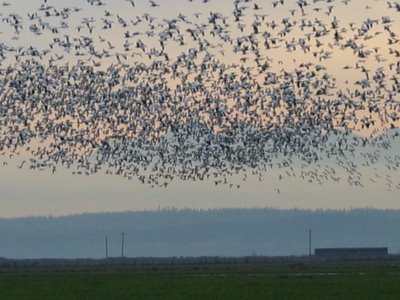
this morning, driving south to work in Sedro Wooley, through the Chuckanut mountains and down into the Skagit flats, I saw several flocks of swans heading northbound.

they were most likely Trumpeter swans, though the valley is full of the smaller Tundra swan as well. whichever, today's big birds moving north in sqwonking Vs were clearly early signs of the impending migration back to Alaska. They arrive noisily in big groups throughout the fall and hunker down in the Skagit Valley for most of the winter. While here, according to one internet naturalist, the swans "spend their winter days in sociable groups in old corn, potato and carrot fields, and their nights out in Skagit Bay, Clear Lake, and Bay Slough." I took these photos last February down near Stanwood; the Olympics are the peaks off in the haze. Indeed.

she continues, "because Trumpeter Swans weigh about 25 pounds and have 8-foot wingspans, they are easy to see against the muddy ground, and just about anywhere else. Trumpeters have a call like a trumpet, with the same tonal quality as badly-played bagpipes. Its smaller cousin the Tundra Swan has a higher-pitched honk. Swans greet each other with musical wing-waggling and head-bobbing displays."

Then I found another cyber-naturalist who countered with "The voice of the Tundra Swan is soft and melodious...They have a mellow, rich bugling call. "
I really like this particular writer's attention to details, both subtle & precise: "As flocks pass overhead, the leader often utters a high note like "who-who-who," which is immediately repeated by flock after flock, producing a high-pitched whistling sound. The call is pitched lower than a whistle and more closely resembles a blowing or tearing sound and can be heard for up to six kilometres.
"The Tundra Swan breeds in the Canadian North in the tundra areas of Hudson's Bay west to Alaska and winters in the Chesapeake Bay marshes of the United States." (You can read more over here.)

March 6. Geese heading north, again. Wind from the south. Length of Day: 11 hours and 19 minutes. Tomorrow will be 3 minutes and 36 seconds longer. Thought you should know.
1 comment:
thanks for sharing your beautiful commute... m
Post a Comment